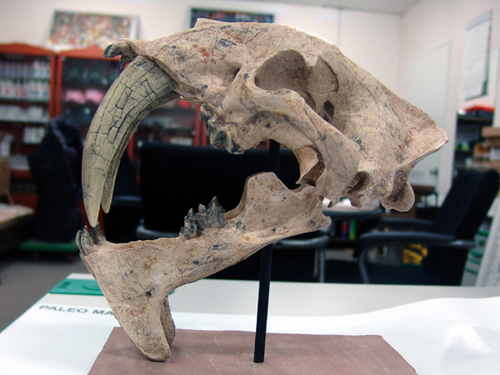검치호랑이 머리(Saber Tooth Tiger Skull) 
판매가 650000
할인판매가 650,000원 총 할인금액 원 (모바일할인금액 원)
적립금
- 0원(0%)
-
원 %
-
원 %
-
원 %
-
 원 %
원 %
-
원 %
-
원 %
-
원 %
-
원 %
| 국내/해외배송 | |
|---|---|
| 배송비 방법 | 택배 |
| 배송비 | 4,000원 (50,000원 이상 구매 시 무료) |
| 수량 |
|
| 상품 정보 | 가격 | 삭제 |
|---|---|---|
| [총 상품금액(수량)] 0 (0개) | ||
일반명 : 검치호랑이 머리(Saber Tooth Tiger Skull)
학 명(Scientific Name) : Eusmilus sicarius Skull
원산지(Location): 미국 (South Dakoda, USA)
지질시대(Age): 플라이스토세(Oligocene Epoch 30.5 - 28.5 million years old)
상태 : 복제본(Replica)Museum quality acrylic display stand available
검치오랑이는 화석을하는 모든이들이 한번쯤은 가지고 싶은 화석동물이다.일반명에서 이미내포하고 있지만 검치호랑이란 이빨이 단검처럼생겨서 붙여진 이름이다. 검치호랑이는 신생대의 대표화석이다. 일반적으로 매머드나 화패석등이 유명하지만 사실은 검치호랑이와 말이 아주 중요한 위치를 차지하고 있으며 신생대 초기에는 공룡의 뒤를 이은 설치류가 매우 중요하기도하다.
검치호랑이는 매우고가이기때문에 모든박물관에서는 레플리카(Replica)전시하고 있다. 표본은 중국에서 발견되고 있는 검치호랑이 인데 미국에서 복제한 표본이다.
One of the smaller Nimravids of the Oligocene, this species is noted for its very long, compressed sabers. It is an excellent example of a dirk-tooth saber cat. This specimen's deciduous sabers are in place and the permanent sabers erupting.
FAMILY THYLACOSMILIDAE: MARSUPIAL "SABRE-TOOTH TIGER"
The jaguar-sized Thylacosmilus ("pouched blade") was a large, predatory marsupial; part of a unique group of predators on the South American pampas; the borhyaenids. These appeared in the Miocene and ruled the South American forests and woodlands for some 30 million years, but have no known ancestor or descendant. Thylacosmilus was the most successful member of that family and was the ultimate mammalian predator of its day in Plio-Pleistocene South America, but when the continents of North America and South America joined, it lost out to the more highly developed and faster eutherian cats.
Two species are described: T atrox and T lentis. Thylacosmilus atrox looked like a sabre-toothed cat, but is more closely related to kangaroos. As far as we know, Thylacosmilus was the only marsupial to have developed the sabre-toothed weapon. Like Smilodon, the eutherian sabre-tooth tiger, it had adapted to hunting mega-fauna.
Thylacosmilus lacked incisor teeth, but had very long upper canine teeth that grew continually. These long stabbing teeth projected below the mouth-line. Strong neck and jaw muscles allowed the sabre-teeth to be driven downward with a tremendous killing force. Its huge stabbing teeth were about 15 cm (6 inches) long (longer than those of Smilodon) and may have been used to slash the soft throat of its prey. The jaws were capable of a gape that left the teeth clear to do their work. These sabres grew continually throughout Thylacosmilus's life, much like the incisors of modern rodents. Unlike Smilodon (see later), it had no scabbard-like tooth-guards on its lower jaw though its skull had a deep flange on its lower jaw, forming a protective sheath for when the sabre teeth were not being used.
Unlike modern cats, which tend to be sleek and long-legged, it appears to have been short-legged and heavily built, being about 1.2 metres (4 ft) long and weighing around 100 kilos. Its claws were not retractile. It probably preyed on large, slow-moving mammals and when the two continents joined, the highly specialised Thylacosmilus could not compete against the faster, sleeker eutherian big cats. South America has also had at least three species of cats whose body weights exceeded 300 kilos - about twice the weight of modern lions.
EVOLUTION OF MODERN CATS (SUMMARY)
Carnivorous mammals evolved from Miacids small pine marten-like insectivores that lived 60 million - 55 million years ago. The miacids split into two lines: Miacidae and Viverravidae. Miacidae gave rise to Arctoidea/Canoidea group (bears and dogs) while Viverravidae gave rise to Aeluroidea/Feloidea group (cats, hyenas, civets, mongooses) around 48 million years ago. The Viverravidae also gave rise to a group called Nimravidae. The Nimravids were cat-like creatures that evolved in parallel with true cats; they are not part of true cat lineage and have left no living descendents.
The first true cat to arise from Viverravidae was Proailurus (first cat") around 30 million years ago. The best-known species was P lemanensis, found in France.
Proailurus was a small weasel-like cat with relatively short legs and a long body. It had one more premolar on each side of its bottom jaw than do modern cats. About 20 million years ago, Proailurus gave rise to Pseudaelurus. Pseudaelurus were Miocene ancestors of cats. Pseudaelurus lorteti was about the size of a large lynx while P validus was the size of a large lynx or small puma. Three other species of early cat are described as Pratifelis, Vishnufelis and Sivaelurus (S chinjienis).Pseudaelurus went on to split into two major groups: the Machairodontinae (true sabre-tooths) and Schizailurus (the ancestor of the modern day Felidae group).
18 million years ago, Schizailurus gave rise to the Felidae. The first of the modern Felids were the early cheetahs; now represented by Acinonyx (modern cheetah); true cheetahs are believed to have evolved around 7 million years ago. Some sources claim Miracinonyx (North American cheetahs) evolved only 4 million years ago from Acinonyx, but recent studies show Miracinonyx was probably ancestral to both cheetahs and puma and was intermediate in type between these two modern species.
Around 12 million years ago, genus Felis appeared and eventually gave rise to many of our small cats. Two of the first modern Felis species were Felis lunensis (Martelli's cat, extinct), and Felis manul (Manul or Pallas's Cat, living). Extinct Felis species are: F attica, F bituminosa, F daggetti, F issiodorensis (Issoire Lynx), F lunensis and F vorohuensis. The ancestor of modern Felis species was F attica. Genus Panthera ("biting cats" or "roaring cats") genera evolved around 3 million years ago; there are a number of extinct species discussed later in this article.
Genera Acinonyx, Felis and Panthera are all represented today and taxa of some modern species is regularly revised as more complete fossils of ancestral species are found, giving a clearer indication of who begat whom and when various lineages split.
NIMRAVIDS: FALSE SABRE-TOOTH CATS
The Nimravidae were a separate family of cat-like animals that evolved parallel to the true cats (Felidae). The common ancestor of the Nimravidae and the Felidae was the Viverravidae (feline-like) group of miacids some 55 million years ago in the late Eocene. Proailurus, a descendent of the miacids, evolved into Pseudaelurus, which split into two main groups, one of which became the modern cats (Neofelids), and one became the Machairodonts (true sabre-toothed cats, a sub-family of the Felidae). Nimravids are also known as the Paleofelids (ancient cats), or False Sabre-toothed Cats (because they are cat-like, but not true cats). They were the earliest cats to evolve and lived from the late Eocene (36 million years ago) to the late Miocene (5 million years ago), peaking around 28 million years ago. The three subfamilies of nimravid and their genera are shown in the table below. Some are known from single or fragmented specimens and the taxonomy may change as more fossils are discovered.
Nimravids had different skulls to true cats. The structure of their middle and inner ear was different and many Nimravids had a flange on the front of the lower jaw (also seen in some machairodonts [true sabre-tooths] and thylacosmilids [marsupial sabre-tooth]). The flange is a bony prominence that projects downwards and is as long as the canine teeth; the teeth fit into a groove. Barbourofelis has the most prominent flange, while Nimravus and Dinaelurus lacked a flange. The actual sabres were narrow, pointed canines whose length varied according to species.
Nimravids were very cat-like in appearance and had retractile claws. Many were muscular and low slung with heavy-set bodies on short legs. Like the modern lynx, some were short-tailed although many others were long-bodied and long-tailed. The skulls of genera Dinictis, Nimravus and Dinaelurus are especially cat-like. Their prominent upper canines were longer than those of modern cats, but shorter than those of the true sabre-toothed cats; their lower canines were proportionally longer. The most common species in the fossil record are those belonging to Dinictis, Eusmilus, Hoplophoneus and Barbourofelis.
Hoplophoneus lived during the late Oligocene (33 - 30.5 million years ago), some 20 million years before Smilodon. Some earlier authors erroneously place Hoplophoneus among the Felidae (true cats) as the ancestor of Smilodon and true sabre-tooths, but current fossil evidence makes this incorrect and indicates that Hoplophoneus and Smilodon are from different evolutionary lines. Some were the size of bobcats while others were jaguar-sized. Like many other Nimravids, Hoplophoneous had a bony flange into which its curved canines fit.
Nimravus has been found in France and parts of North America from the early Oligocene to early Miocene. Some were 1.2 metres (4 ft) long. With its sleek body, it may have resembled the modern caracal, although it had a longer back and more dog-like feet with partially retractile claws. It competed with other false sabre-tooths such as Eusmilus. A Nimravus skull, found in North America, had been pierced in the forehead region, the hole exactly matching the dimensions of Eusrnilus' sabre tooth; Nimravus survived as the wound showed signs of healing. It probably hunted birds and small mammals, ambushing them like modern cats, rather than chasing them down. Some specimens still have unclear classification, for example a species once identified as N catacopis is closer to true cats and is now classified as Machairodus aphanistus (previously Machairodus catacopis).
Dinictis was a small nimravid that lived on the plains of North America during the late Eocene and early Oligocene (40 million years ago). Dinictids had a sleek bodies, short legs, long tails, and walked plantigrade ("on the whole foot" modern cats walk digitigrade "on the toes").
Eusmilus was a dirk-toothed cat found in France and parts of North America during the late Oligocene (30.5-28.5 million years ago). It was noted for its long, flattened sabres and very prominent mandibular flange. Most were leopard-sized and rather long-bodied and short-legged compared to modern leopards. Some reached 2.5 metres (8 ft) long. It was a typical false sabre-tooth with enlarged upper canines, but insignificant lower canines, while many of the other teeth had been lost to accommodate its sabres (Eusmilus had 26 teeth, compared to 44 teeth in other carnivores). The jaw hinge was modified to open to an angle of 90 degrees to allow the great sabre teeth to do their work. Its lower jaw had bony guards that lay along the length of the sabres, protecting them from damage when the mouth was closed. There is fossil evidence of conflict between Eusmilus and Nimravus.
The lion-sized Barbourofelis was one of the most recent members of the Nimravidae family. It lived during the late Miocene (15 million - 6 million years ago) and had the longest canines of all the nimravids. They had very prominent flanges on the lower jaws and an unusually shaped skull. The Barbourofelids were probably very muscular, resembling a bear-like lion or lion-like bear. Pogonodon was a cat-like sabre-tooth.
http://www.messybeast.com/cat-prehistory.htm













 확대보기 및 상세정보
확대보기 및 상세정보